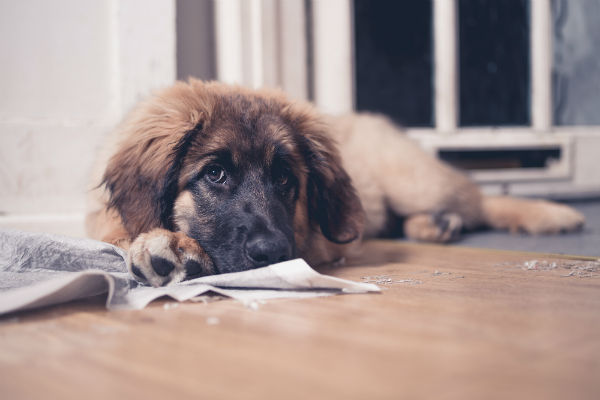Your new puppy has been home for two days, and you are already wondering how you are going to keep her from tearing the house down. Shouldn’t she know better?
First, remember that this is a baby dog, no different than a human toddler. Don’t expect your puppy to understand that she should not chew on cords, shoes, furniture, windowsills, and your children’s toys. Anything within reach is fair game. Puppies are curious and eager to test their newfound skills by exploring and tasting everything they see. They require management and guidance, so that they, and your possessions, stay safe. This puppy/toddler phase may make you wonder what you were thinking when you decided to get a dog, but it passes quickly, and we have tips to help you survive it.
Turning a new puppy loose in the house is asking for trouble. It’s important to puppy-proof an area of your house for the safety of both puppy and possessions. Accidents do happen. But if you set your house up so little Fluffy never gets a chance to cause trouble, she won’t develop undesirable habits, and some training will automatically occur.
Designate one room that is puppy-proofed. Use baby gates to confine the puppy to this area. Fasten any electrical cords out of the way. If the chosen room is the kitchen, use cabinet door locks designed for toddlers. Find supplies for human toddlers, including baby gates and outlet covers, at baby or home-improvement stores. Look at this room from the puppy’s level. Get on your hands and knees, and you’ll notice more things that should be moved, such as throw rugs, tablecloths, and low shelves filled with books and knickknacks.

This puppy-proofed room is a good place for your new friend to be when you are home, but when you need to leave him alone, a crate or puppy pen is the safest option. If it’s for a long time, a crate with the door open in a pen will work. This is where he should be at any time he isn’t being watched. Every time you put your puppy here, give him a treat and chew toy to keep him busy. It should be something special that he only gets at these times. This will give him a reason to think being in his crate or pen is a good thing. If your puppy is destroying his cushy beds, take them away. He can make do with a simple rug or nothing at all, if even a flat rug or cushion is too tempting to chew.
Get all family members on the same page. It’s practically impossible to keep the whole house picked up, but one room should be doable. Nobody should leave shoes, socks, toys, or books — anything they value — in the puppy-proof room. If young children are in the house, adults need to be sure this rule is followed.
Keeping the puppy’s area small is important. He needs to earn the privilege of more real estate in your home. He does not need free run of the house any more than a 3-year-old child needs to have your car keys.
There is no getting around the fact that puppies need lots of attention. They want to be with you. If you play with and exercise your puppy several times every day, give her plenty of opportunities to relieve herself outside, and start training in short, fun sessions, you do not need to feel guilty about using a crate to keep her safe. Before you know it, she will have grown into a trustworthy family companion.
To find crates, toys, and other supplies for your puppy, visit https://shop.akc.org/
For training advice and help with your puppy throughout her entire life, AKC’s GoodDog! Helpline trainers are there to help. Go to www.akcgooddoghelpline.org to learn more.


